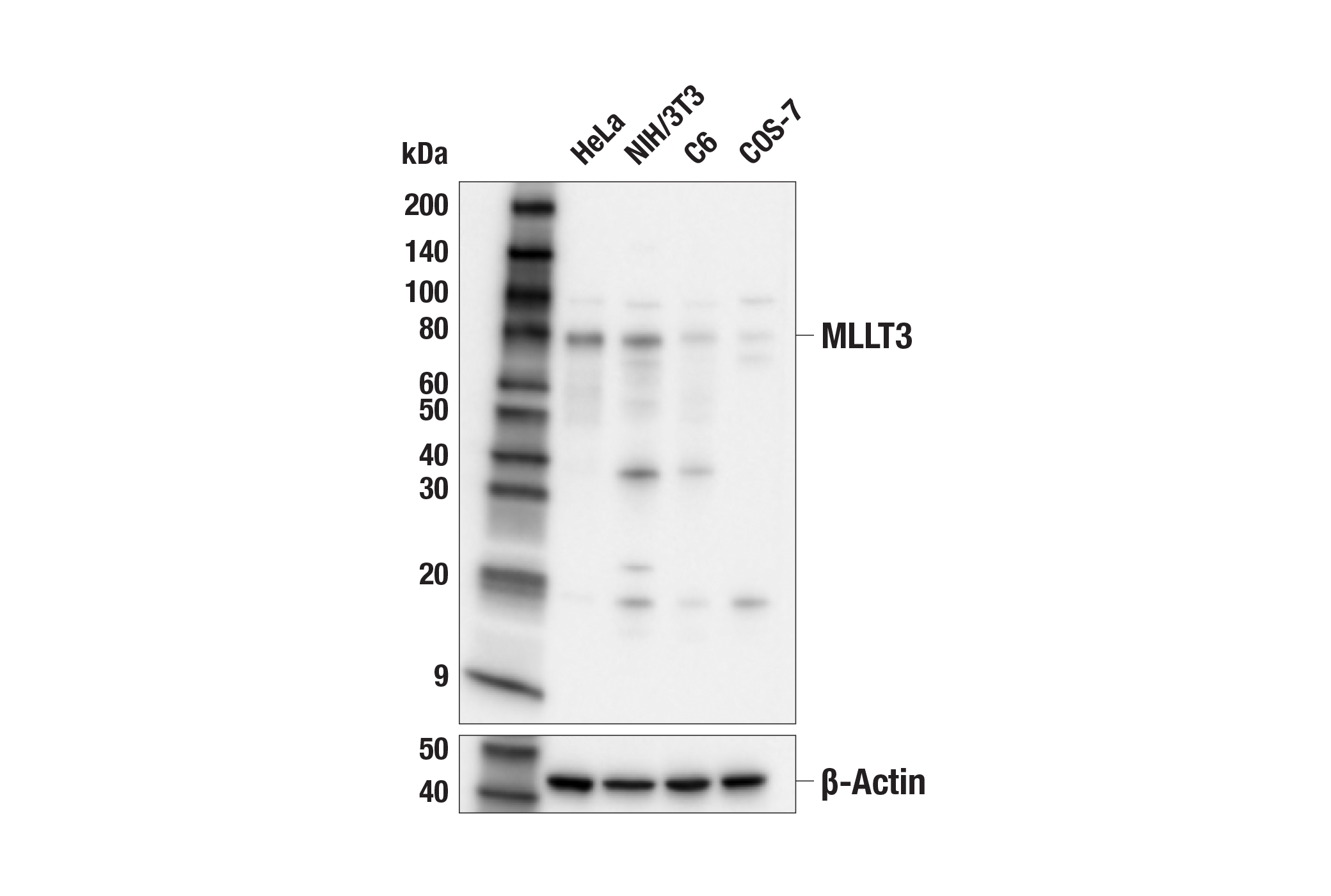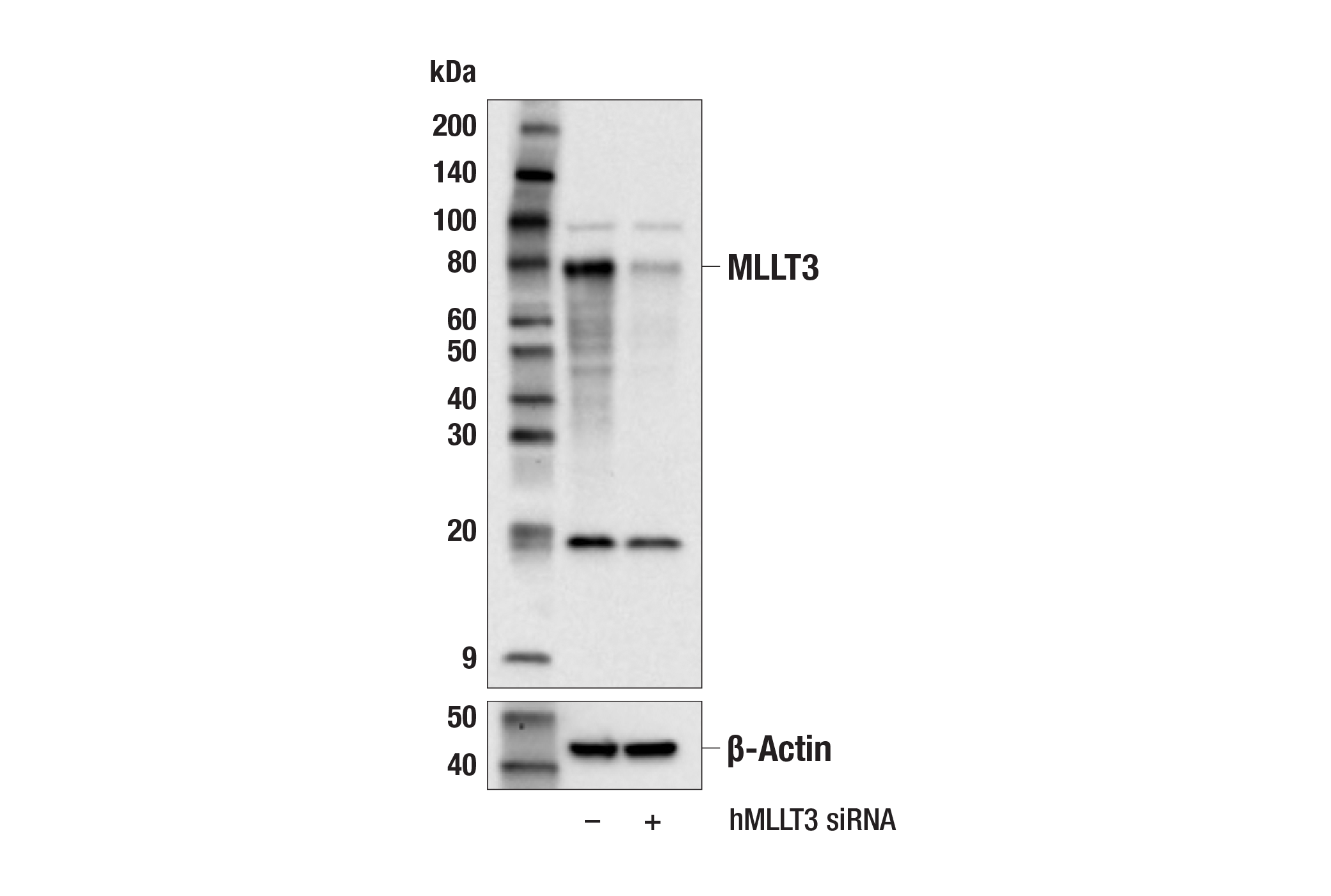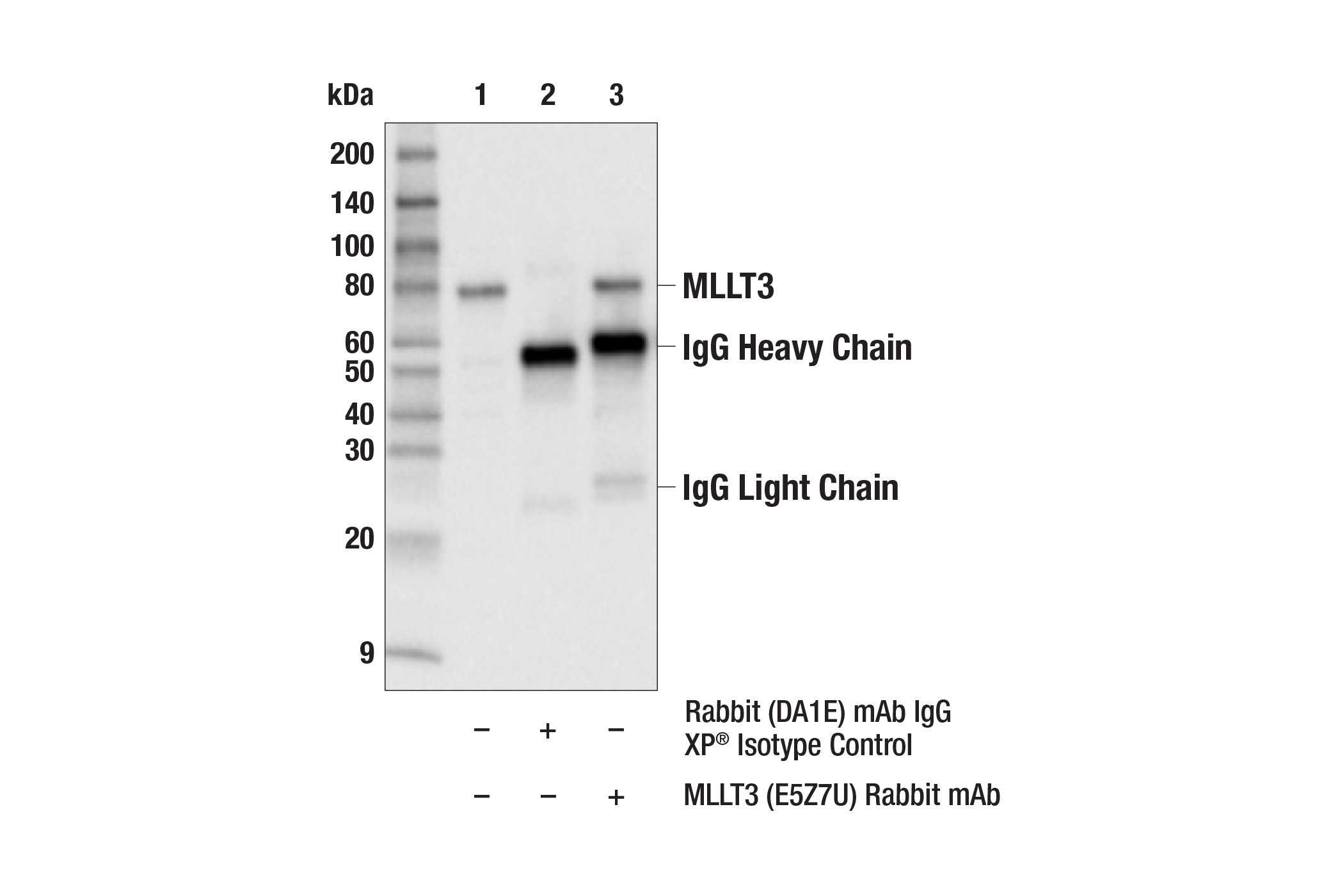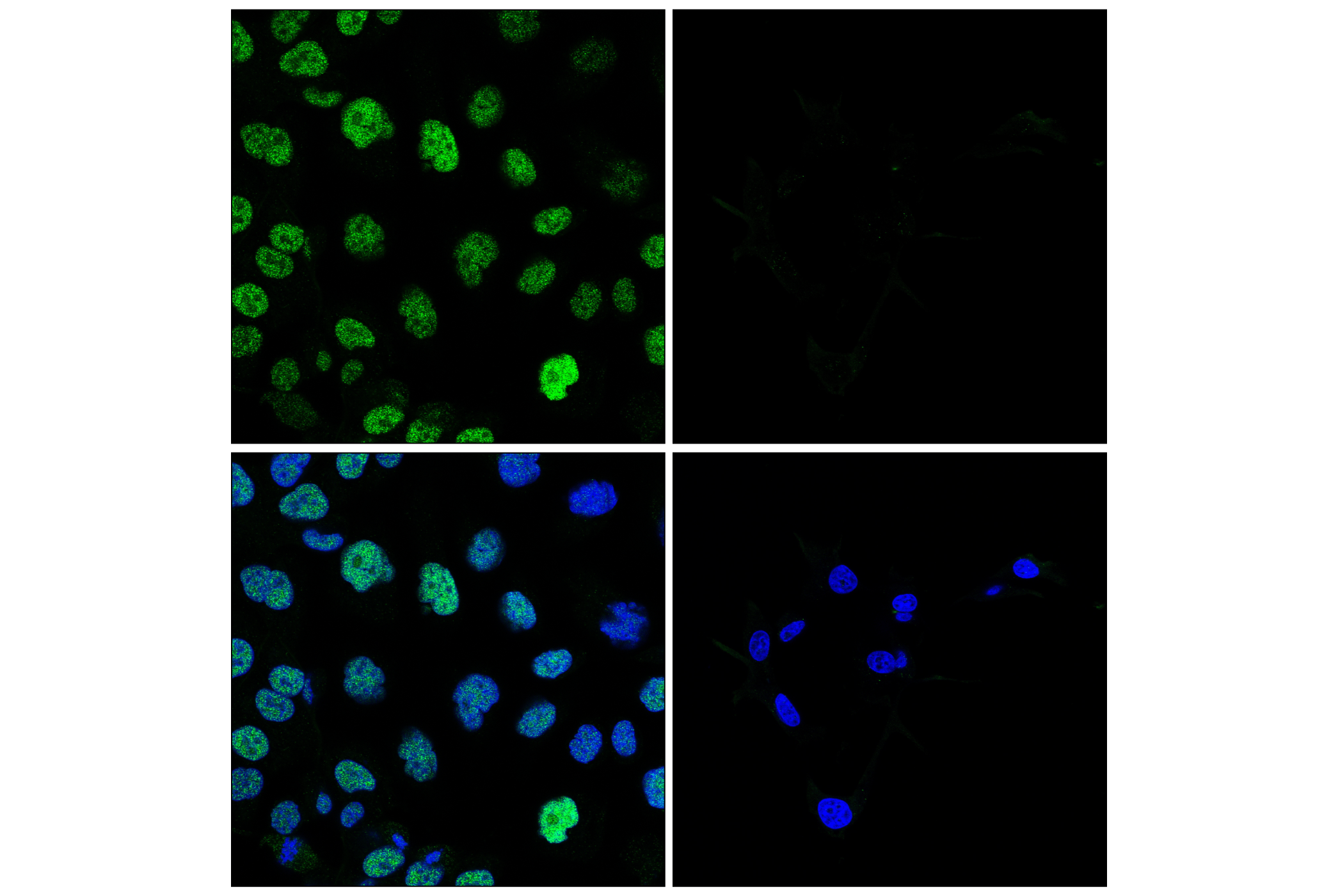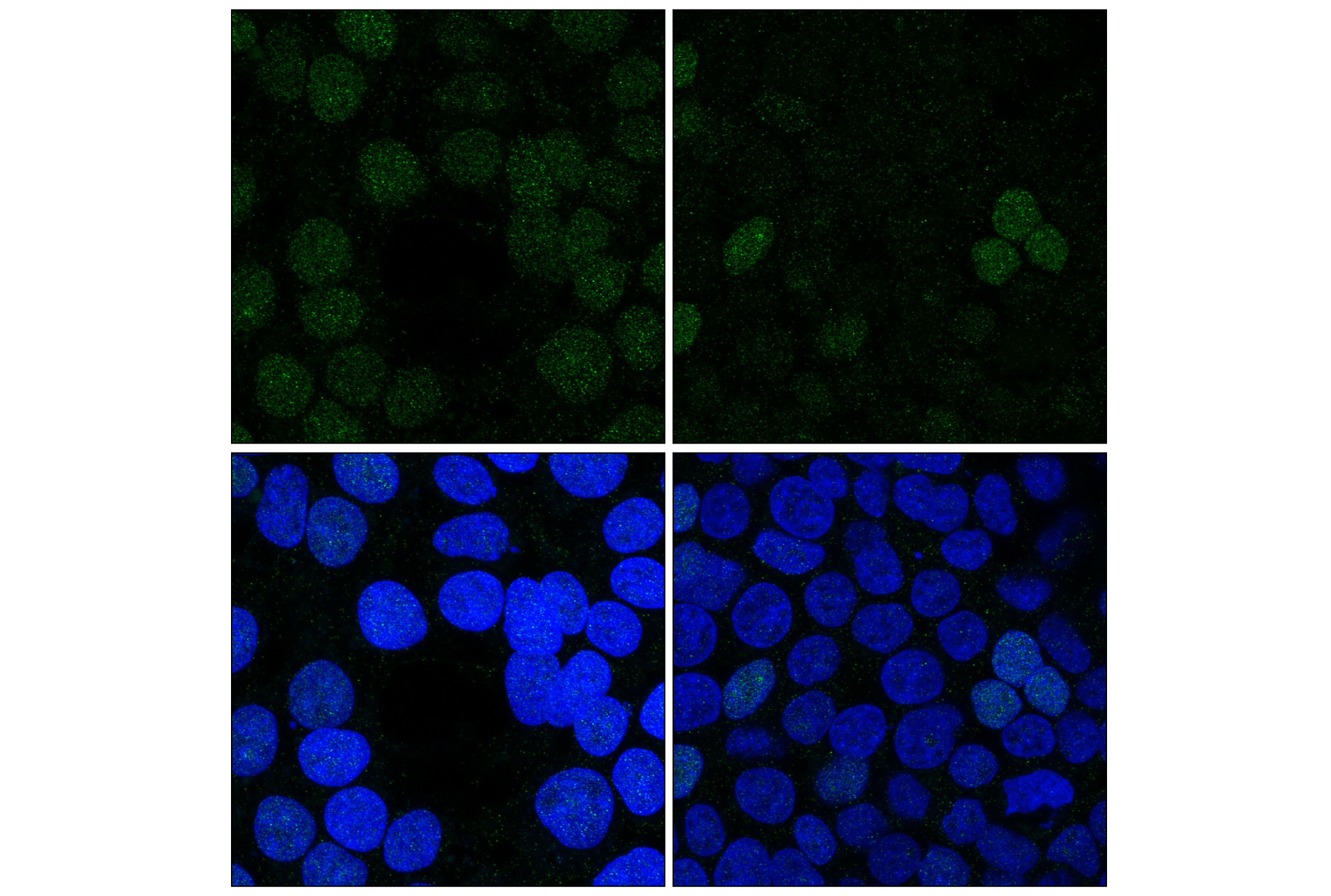WB, IP, IF-IC
H M R Mk
Endogenous
80
Rabbit IgG
#P42568
4300
Product Information
Product Usage Information
| Application | Dilution |
|---|---|
| Western Blotting | 1:1000 |
| Immunoprecipitation | 1:50 |
| Immunofluorescence (Immunocytochemistry) | 1:6400 |
Storage
Specificity / Sensitivity
Species Reactivity:
Human, Mouse, Rat, Monkey
Source / Purification
Monoclonal antibody is produced by immunizing animals with a synthetic peptide corresponding to residues surrounding Ala217 of human MLLT3 protein.
Background
The super elongation complex (SEC) plays a critical role in regulating RNA polymerase II (RNAPII) transcription elongation (1). The SEC is composed of AFF4, AFF1/AF4, MLLT3/AF9, and MLLT1/ENL proteins. The pathogenesis of mixed lineage leukemia is often associated with translocations of the SEC subunits joined to the histone H3 Lys4 methyltransferase mixed lineage leukemia (MLL) gene (1-4). The SEC has been found to contain RNAPII elongation factors eleven-nineteen lysine-rich leukemia (ELL), ELL2, and ELL3, along with the associated factors EAF1 and EAF2, which can increase the catalytic rate of RNAPII transcription in vitro, (1,2,5-7). The SEC positive transcription elongation factor b (P-TEFb) phosphorylates the carboxy-terminal domain within the largest subunit of RNAP II at Ser2 of the heptapeptide repeat. The SEC negative transcription elongation factors, DRB-induced stimulating factor (DSIF) and negative elongation factor (NELF), signal the transition from transcription initiation and pausing to productive transcription elongation (2,8-10). The chromosomal translocation of MLL with the members of the SEC leads to SEC recruitment to MLL regulated genes, such as the highly developmentally regulated HOX genes, implicating the misregulation and overexpression of these genes as underlying contributors to leukemogenesis (1,2,9,11).
- Mohan, M. et al. (2010) Nat Rev Cancer 10, 721-8.
- Lin, C. et al. (2010) Mol Cell 37, 429-37.
- Drexler, H.G. et al. (2004) Leukemia 18, 227-32.
- Smith, E. et al. (2011) Genes Dev 25, 661-72.
- Shilatifard, A. et al. (1996) Science 271, 1873-6.
- Shilatifard, A. et al. (1997) Proc Natl Acad Sci U S A 94, 3639-43.
- Miller, T. et al. (2000) J Biol Chem 275, 32052-6.
- Lin, C. et al. (2011) Genes Dev 25, 1486-98.
- Yokoyama, A. et al. (2010) Cancer Cell 17, 198-212.
- Cho, S. et al. (2010) Cell Cycle 9, 1697-705.
- Shah, N. and Sukumar, S. (2010) Nat Rev Cancer 10, 361-71.
Species Reactivity
Species reactivity is determined by testing in at least one approved application (e.g., western blot).
Western Blot Buffer
IMPORTANT: For western blots, incubate membrane with diluted primary antibody in 5% w/v nonfat dry milk, 1X TBS, 0.1% Tween® 20 at 4°C with gentle shaking, overnight.
Applications Key
WB: Western Blotting IP: Immunoprecipitation IF-IC: Immunofluorescence (Immunocytochemistry)
Cross-Reactivity Key
H: human M: mouse R: rat Hm: hamster Mk: monkey Vir: virus Mi: mink C: chicken Dm: D. melanogaster X: Xenopus Z: zebrafish B: bovine Dg: dog Pg: pig Sc: S. cerevisiae Ce: C. elegans Hr: horse GP: Guinea Pig Rab: rabbit All: all species expected
Trademarks and Patents
Limited Uses
Except as otherwise expressly agreed in a writing signed by a legally authorized representative of CST, the following terms apply to Products provided by CST, its affiliates or its distributors. Any Customer's terms and conditions that are in addition to, or different from, those contained herein, unless separately accepted in writing by a legally authorized representative of CST, are rejected and are of no force or effect.
Products are labeled with For Research Use Only or a similar labeling statement and have not been approved, cleared, or licensed by the FDA or other regulatory foreign or domestic entity, for any purpose. Customer shall not use any Product for any diagnostic or therapeutic purpose, or otherwise in any manner that conflicts with its labeling statement. Products sold or licensed by CST are provided for Customer as the end-user and solely for research and development uses. Any use of Product for diagnostic, prophylactic or therapeutic purposes, or any purchase of Product for resale (alone or as a component) or other commercial purpose, requires a separate license from CST. Customer shall (a) not sell, license, loan, donate or otherwise transfer or make available any Product to any third party, whether alone or in combination with other materials, or use the Products to manufacture any commercial products, (b) not copy, modify, reverse engineer, decompile, disassemble or otherwise attempt to discover the underlying structure or technology of the Products, or use the Products for the purpose of developing any products or services that would compete with CST products or services, (c) not alter or remove from the Products any trademarks, trade names, logos, patent or copyright notices or markings, (d) use the Products solely in accordance with CST Product Terms of Sale and any applicable documentation, and (e) comply with any license, terms of service or similar agreement with respect to any third party products or services used by Customer in connection with the Products.
